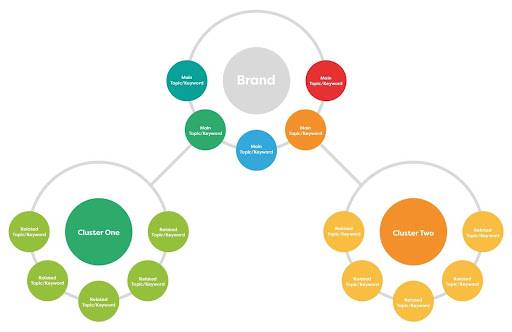
Website owners often strive for greater visibility on search engines. An effective method to enhance search engine rankings is utilizing SEO topical clusters. Organizing content around connected subjects boosts your website’s relevance and authority, often resulting in superior rankings and increased traffic.
This strategy involves creating a comprehensive “pillar” content piece that provides a broad overview of a topic, and then linking to more detailed “cluster” content that addresses specific aspects of that topic. By structuring your content in this interconnected manner, search engines can more easily understand the depth and breadth of your site’s expertise, making it more likely to rank higher for related queries.
Additionally, this approach improves the user experience by making it easier for visitors to find the information they need, encouraging longer site visits and higher engagement rates. Implementing SEO topical clusters not only signals to search engines that your site is a valuable resource on a particular subject but also positions your website as a thought leader in your industry.
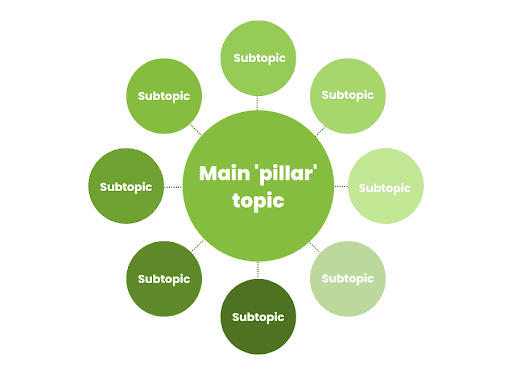
Topic clusters include a central pillar page that overviews a subject, surrounded by cluster pages on related subtopics, helping websites to appear for a greater variety of searches while showcasing their knowledge. For instance, a culinary site might have a ‘healthy eating’ pillar page, with ‘vegetarian recipes’ and ‘gluten-free meals’ as cluster topics, thereby enhancing their relevance across these areas.
This method not only amplifies the site’s authority on healthy eating but also captures a wider audience by addressing specific dietary preferences and needs. Moreover, by linking these cluster pages back to the pillar page, the site strengthens its internal linking structure, which is beneficial for SEO. This interconnected content strategy enables search engines to crawl the site more efficiently and recognize the comprehensive coverage of topics.
As a result, the website can achieve higher rankings for both broad and niche queries, drawing in more targeted traffic. Implementing topic clusters thus serves as a dual-purpose strategy, improving search visibility while positioning the website as a go-to resource for both general and specific information within its niche.

*Image shows where we segmented over 120 blogs on an eCommerce Shopify site, placing them into pillars that drove the company’s goals. We segmented, updated internal links and re-indexed the entire site.
Search engine algorithms are now more sophisticated, favoring content that exhibits clear expertise on a subject. The organization into topic clusters removes content redundancies and presents a structured knowledge base. HubSpot’s website overhaul exemplifies this, leading to improved rankings by ensuring clarity in their site’s thematic structure.
By organizing their content into distinct, yet interconnected topic clusters, HubSpot effectively showcased its authority across various marketing, sales, and service domains. This strategy not only enhanced the user experience by making information more accessible and easier to navigate but also signaled to search engines the depth of their expertise in each area.
Such a strategic approach to content organization helps search engines understand the relationships between different content pieces, allowing them to more accurately gauge the site’s value to users and assign higher rankings. Furthermore, this model encourages the creation of more comprehensive and detailed content, pushing websites to delve deeper into their subjects and cover aspects that may have been overlooked in a more scattered content strategy.
The success seen by HubSpot demonstrates the power of topic clusters in aligning with modern SEO practices that prioritize topic authority and content quality over keyword density, offering a blueprint for other sites aiming to achieve similar results.
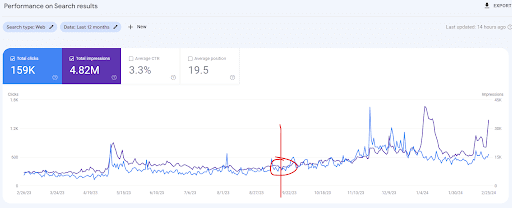
*Image above demonstrates just how powerful a good pillar strategy can be. Red line indicates when we took one of our clients to a pillar strategy.
With a focused topic cluster structure, discoverability improves as search engines can more readily ascertain site expertise. This strategy involves in-depth content creation tied to the pillar content, reducing the likelihood of keyword overlap, enabling the site to cover a broader range of relevant queries, and better positioning the site as an industry authority.
Additionally, this approach facilitates a more intentional and strategic use of keywords within and across the cluster content, ensuring that each piece targets specific aspects of the broader topic while maintaining a cohesive narrative. This not only enhances the site’s SEO performance by catering to a wide spectrum of search intents but also significantly improves the user experience by providing comprehensive and organized content that meets diverse user needs.
By thoroughly covering a topic through interconnected pieces, websites can capture long-tail keywords and questions that are often more specific and less competitive, driving targeted traffic that is more likely to convert. Moreover, this structured approach to content creation and organization encourages ongoing content development, prompting websites to continually update and expand their topic clusters. This dynamic process keeps the content fresh and relevant, further signaling to search engines the site’s commitment to providing valuable and up-to-date information, which is crucial for maintaining and enhancing search engine rankings over time.

Choosing the central theme is the beginning of building an SEO topical cluster. Effective clusters convey thorough knowledge on a broad subject. For improved search performance, connecting with in-depth cluster content is vital, building a robust foundation for a website’s content strategy.
This involves not only selecting a theme that resonates with your target audience but also identifying subtopics that fill gaps in existing content or address emerging trends within the industry. Each piece of cluster content should offer unique insights or valuable information, encouraging users to explore your site further.
This interconnected content network does more than boost SEO; it engages and educates your audience, establishing your site as a go-to resource. Additionally, incorporating various content formats such as blogs, infographics, videos, and case studies within your clusters can cater to different learning styles and preferences, further enriching the user experience.
By meticulously planning and executing a topic cluster strategy, you create a synergistic effect that amplifies the reach and impact of your content, driving both search engine visibility and user engagement.
Effective keyword research within your niche will help to identify subtopics related to the central theme, enhancing content strategy. For instance, dissecting ‘digital marketing’ may yield ‘social media marketing‘ and ‘content marketing‘ as sub-niches. Composing these terms into your clusters can extend your reach and bolster topic relevance.
Additionally, leveraging tools like Google’s Keyword Planner or SEMrush for this research can uncover long-tail keywords and questions that your target audience is actively searching for, which might not be immediately apparent. Integrating these insights into your cluster content not only caters to specific user intents but also captures a wider array of search queries, significantly improving your site’s visibility. This strategic inclusion of diverse but related keywords ensures that your content remains comprehensive and authoritative, addressing various facets of the main theme.
Furthermore, it allows for the natural integration of keywords, which is favored by search engines and avoids the pitfalls of keyword stuffing. By thoughtfully mapping out your topic clusters around both broad and niche keywords, you create a content ecosystem that is rich, informative, and aligned with user search behavior, setting a solid foundation for sustained SEO success.

Pillar and supporting content work in tandem within topic clusters. A solid pillar page provides an encompassing view of a subject, while supporting content delves into specifics. As this network of related content escalates search rankings, employing tools like Semrush enriches optimization.
These platforms offer invaluable insights into keyword trends, competitor content strategies, and backlink opportunities, facilitating a data-driven approach to both content creation and refinement. By leveraging such analytics, content creators can pinpoint areas that need enhancement, uncover new subtopics for expansion, and fine-tune existing materials to align more closely with user intent.
Tools like Semrush also play a crucial role in tracking the overall effectiveness of your SEO strategy, including ranking changes and alerting to any technical issues that might affect site performance. Utilizing these resources within your topic cluster strategy not only sharpens your SEO efforts but ensures your content stays relevant and competitive, bolstering your authority and visibility in search engine results.
This approach to managing content and SEO creates a responsive and evolving content ecosystem that adapts to the changing needs of your audience and the dynamics of search engine algorithms.
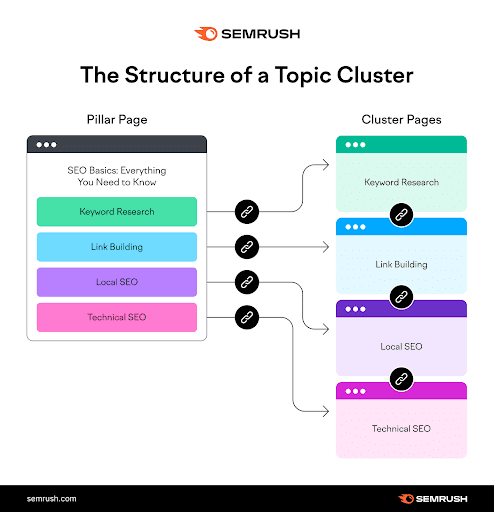
Internal linking is paramount in reinforcing topic clusters. It connects cluster pages to a pillar page, weaving a stronger network of information. Strategic internal linking not only aids navigation but leverages the collective strength of content to enhance topic authority and search engine performance.
This approach allows users and search engines to seamlessly navigate and comprehend the scope of content available on your site, leading to better user engagement and prolonged site visits. Strategic internal linking also distributes page authority and link equity across the website, boosting the SEO value of individual pages and the site as a whole.
By ensuring these links are relevant and enhance the reader’s journey, a more cohesive and user-friendly website is created. This interconnected network of content signals to search engines that your site is an exhaustive resource on specific topics, increasing the likelihood of higher rankings.
This strategy also encourages visitors to explore your site more thoroughly, raising page views and reducing bounce rates—important metrics for search engines. In essence, strategic internal linking within topic clusters is a cornerstone of a comprehensive SEO strategy, driving user satisfaction and enhancing search engine visibility.
Organized topic clusters can preempt keyword cannibalization. With a structured approach led by pillar content, a clear hierarchy is established, alleviating internal competition and promoting clearer topic authority to search engines, as advocated by digital marketing experts.
This method ensures that each piece of content serves a distinct purpose within the broader subject area, targeting specific keywords without overlapping unnecessarily. By delineating the roles of pillar and cluster pages, websites can cover a wide array of related keywords and phrases, enhancing their visibility across multiple search queries.
This strategic organization not only improves the site’s SEO efficiency but also enriches the user experience by providing a well-defined pathway through related content. Search engines, recognizing this structured dissemination of information, are more likely to rank these pages higher for their respective queries.
Moreover, this approach facilitates the identification of gaps in content, guiding the creation of new articles that address unexplored facets of the topic, further solidifying the site’s authority and mitigating the risk of keyword cannibalization. In summary, the strategic implementation of topic clusters not only combats the potential pitfalls of keyword overlap but also establishes a robust foundation for sustained SEO success and audience engagement.
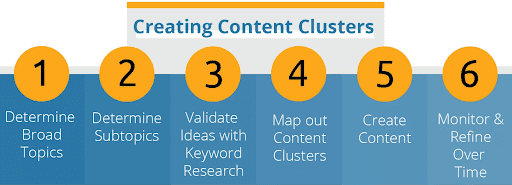
Making use of autocomplete suggestions is an innovative approach to expand topics within clusters. These suggestions assist in layering the central subject with an array of nuanced content that mirrors search trends, significantly impacting SEO effectiveness.
This strategy taps into the real-time queries of users, revealing the specific language and questions they use when seeking information online. By incorporating these insights into your content strategy, you can create articles, blog posts, and guides that directly answer the emerging needs and interests of your target audience.
This not only boosts the relevance of your content in the eyes of search engines but also enhances user engagement by providing precisely the information searchers are looking for. Autocomplete suggestions can uncover long-tail keywords and phrases that may not be immediately obvious, offering opportunities to capture traffic from less competitive queries.
As a result, your content becomes more accessible to a broader audience, driving increased organic traffic and establishing your website as a trusted authority in your niche. Leveraging autocomplete suggestions for topic expansion within clusters is thus a dynamic method to align your content more closely with user intent and search engine algorithms, propelling your SEO strategy forward.
Keyword exploration benefits greatly from using specialized tools, allowing for the discovery of relevant terms and content creation guided by search engine preferences. This strategy sharpens topical focus and enriches cluster content for better search engine coverage.
Platforms like Google’s Keyword Planner, Ahrefs, and Moz delve into keyword metrics such as search volume, competition level, and keyword difficulty, empowering creators to select their targets strategically. Leveraging these insights, content developers can produce material that not only appeals to their audience but also meets search engines’ criteria for quality and relevance.
This ensures that every content piece within a cluster contributes significantly to the overall theme and achieves prominence on search engine results pages (SERPs). These tools often suggest related keywords and questions, broadening the scope for comprehensive topic coverage.
This integrated approach to keyword research and content creation results in a more engaging and informative website, fostering longer visits and higher interaction rates, which signal to search engines the value and authority of your site within its niche.

The ongoing cultivation of topic clusters is instrumental in upholding SERP visibility. The ongoing refinement of pillar and cluster pages, as demonstrated by successful companies, remains critical for staying ahead in a dynamic search landscape. This continuous process involves regularly updating content to reflect the latest industry trends, technological advancements, and user queries, ensuring that your website remains relevant and authoritative.
By systematically reviewing and enhancing your topic clusters, you can address any emerging gaps in content, integrate new keywords, and improve the overall quality and depth of information provided. This proactive approach not only maintains the freshness of your content in the eyes of search engines but also reinforces your site’s position as a trusted source of information for users.
Regularly revisiting your topic clusters to optimize for the latest SEO best practices and user preferences ensures that your content strategy adapts to the evolving digital environment, securing your website’s competitive edge in attracting and retaining audience attention on SERPs.
![]()
Assessing the impact of topic clusters on SEO is essential. Tracking tools like Semrush’s Position Tracking facilitate the monitoring of keyword rankings and traffic acquisition, thereby providing insights into content performance and opportunities for optimization.
This analytical approach allows for a data-driven understanding of how well each cluster is resonating with your target audience and search engines. By evaluating metrics such as page views, bounce rates, and conversion rates in conjunction with keyword performance, you can identify which topics and subtopics are most engaging and worthy of further development or refinement.
This continuous loop of analysis, insight, and action enables you to fine-tune your content strategy, focusing on areas that drive the most value. Moreover, understanding the interplay between different clusters and their collective impact on your site’s SEO helps in strategizing cross-linking and content promotion efforts, ensuring a cohesive user experience and maximizing the visibility of your entire content ecosystem. Tracking the performance of your topic clusters is thus a cornerstone of maintaining and enhancing your online presence, guiding strategic decisions that elevate your website’s authority and search engine rankings.
SEO topical clusters represent a pivotal strategy for enhancing your website’s visibility and authority on search engines. This method, centered around the creation of pillar content and its supporting cluster pages, not only facilitates a more organized presentation of information but also significantly boosts your site’s SEO performance. By adopting a structured approach to content creation, you align your website with the preferences of both your audience and search engine algorithms, ensuring that your content is easily discoverable and highly relevant.
The impact of implementing topic clusters extends beyond just improved search rankings. It transforms your website into a comprehensive resource for your audience, covering a wide spectrum of related topics and subtopics. This not only positions your website as a thought leader in your industry but also enhances the user experience, making it easier for visitors to navigate through your content and find the information they need.
Moreover, the strategic use of topic clusters helps to prevent keyword cannibalization, ensuring that each piece of content uniquely contributes to the overall theme without competing against each other for search engine rankings. This harmonious content ecosystem enables your website to cover a broader range of relevant queries, attracting a wider audience and driving more targeted traffic to your site.
Utilizing tools like autocomplete suggestions and keyword research platforms further enriches your content strategy, enabling you to tap into the latest trends and user queries. This ensures that your topic clusters remain dynamic, relevant, and aligned with the evolving interests of your audience and the ever-changing landscape of search engine optimization.
As the digital world continues to grow and evolve, the importance of a well-structured SEO strategy cannot be overstated. Topic clusters offer a robust framework for achieving sustained SEO success, making it an indispensable tool for any website looking to enhance its online presence. By continuously developing and refining your topic clusters, you can maintain a strong SERP presence, adapt to the changing digital environment, and ensure that your website remains a valuable and authoritative source of information for your audience.
